During its I/O 2024 keynote session, Google announced a plethora of artificial intelligence (AI)-based updates. These encompassed the introduction of new AI models, enhancements to existing foundational models, integration of AI features into Google's products, and more. The company also emphasized AI safety and extended the application of its proprietary watermarking technology for AI-generated content, known as SynthID. This advanced toolkit will now embed watermarks for text produced by the Gemini app and web client, as well as videos generated by Veo.
SynthID was initially introduced by Google DeepMind in August 2023 as a beta project designed to accurately label AI-generated content. The necessity for such a solution arose due to the proliferation of instances where synthetically generated media was circulated as authentic. These instances were often utilized for spreading misinformation and engaging in cybercrimes like phishing. In November 2023, Google utilized this technology for the first time to watermark AI-generated audio created through its Lyria model. The toolkit applied watermarks in the form of a waveform to the audio, making them imperceptible yet detectable.
Now, Google is broadening the application of SynthID to encompass text and video generation. It will apply watermarks to text generated using the Gemini app and website. To achieve this, the toolkit will target the generation process itself. Each text-based AI model employs tokens — which can represent words, syllables, or phrases — for training purposes. The training process also involves understanding the sequencing of these tokens, or the order in which they should be arranged to generate the most coherent response.
SynthID introduces "additional information in the token distribution at the point of generation by modulating the likelihood of tokens being generated." This method assigns a numerical value to certain words in a block of generated text. When determining whether AI was involved in generating the text, it compares the score against adjusted probability scores to ascertain whether the source could be an AI model. DeepMind emphasized in a post that this technique is particularly useful when AI generates lengthy creative text, as probability models can more effectively analyze its creation process. However, for shorter factual responses, the detection may be less accurate.
The company is also extending SynthID to include Veo's recently unveiled AI-generated videos. Google stated that the technology will embed watermarks directly into the pixels of every video frame, rendering them imperceptible to the human eye but detectable by a detection system.
In the upcoming months, Google intends to open-source SynthID text watermarking through its Responsible Generative AI toolkit. Additionally, it will release a comprehensive research paper elucidating the text watermarking technology.























